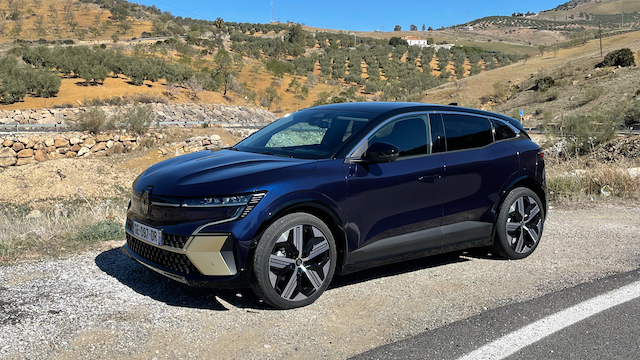02/03/2022 Renault says the new Mégane combines an SUV-like front end and compact saloon body, Mary Shelley would be proud of that description. In the flesh the electric Volkswagen ID.3 rival is no monster. Its high sided exterior design combined with a relatively low roofline is notably aerodynamic. The new EV’s high waist and large wheels presents a sturdy, solid and weighty presence. Despite its ingot like silhouette the new Mégane is circa 100kgs lighter than the equivalent ID.3, making the French built car positively svelte for an electric car.
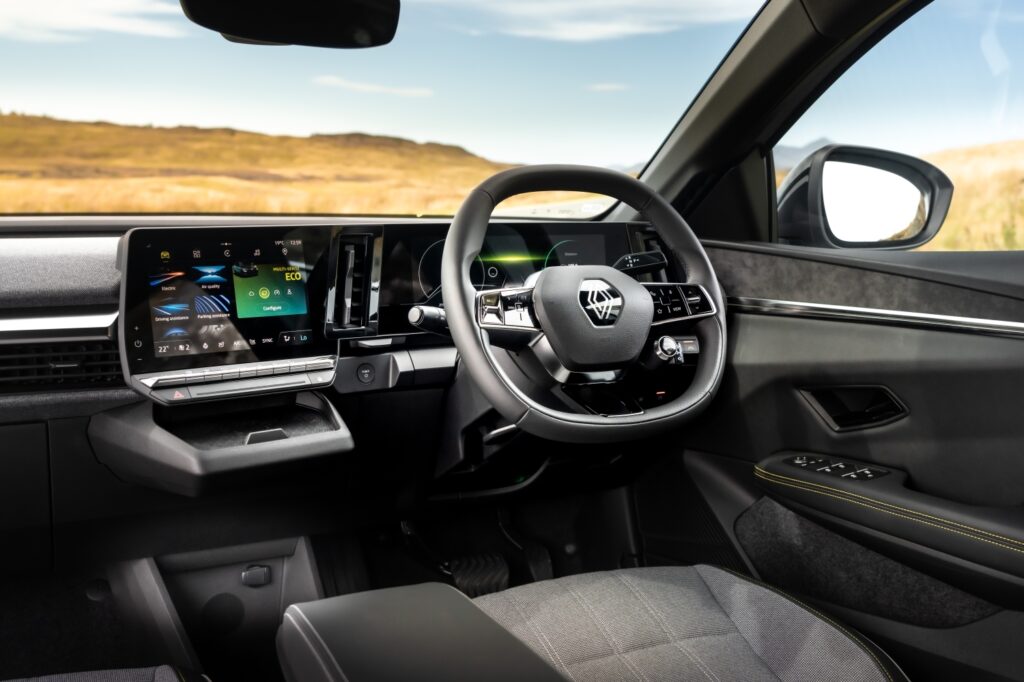
The cabin is comfortable, spacious and high tech. A well-proportioned dash mounted housing incorporates digital and touch displays with a nice ratio of touch and analogue buttons. The most significant tech advance sees the Mégane gets enhanced connectivity via a new partnership with Google. Thanks to its new architecture lots of driving aids and gizmos will be available. One that caught our eye or in fact didn’t is Renault’s ‘Living Light’ (sounds like a religious affairs TV programme) that adapts Mégane’s interior lighting to follow our circadian rhythm. A highly equipped launch version and a further two grades are expected to feature when Irish cars start to arrive late summer – the bulk will be for 2023 delivery. Four adults can sit in comfort in the five-seat cabin. The boot capacity is relatively modest with no spare wheel but at least there is a decent underfloor EV cable stowage area. The rear floor is flat making passenger access relatively painless. Kids in the back won’t thank Renault for the sleek exterior design as their windows don’t wind fully down and visibility is restricted.
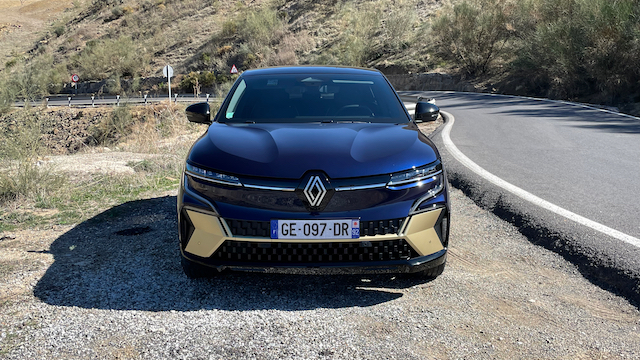
The Mégane E-Tech Electric is built on the new CMF-EV alliance platform. Initially all models will be front wheel drive but there is space in the chassis for a rear motor to facilitate all-wheel drive. Two 400-volt batteries are offered housed in a slim 11cm high pack with net capacities of 40kWh and 60kWh. The lithium-ion battery pack sits under the floor (the larger battery has additional modules under the rear bench). The entry point EV40 has a 130hp motor, while the EV60 has the option of the 130hp/250nm motor or more spirited 220hp/300nm motor fitted to our test cars. The high-performance model delivers the shortest range of 300km from a full charge. A highly impressive 450km is quoted for the EV40.
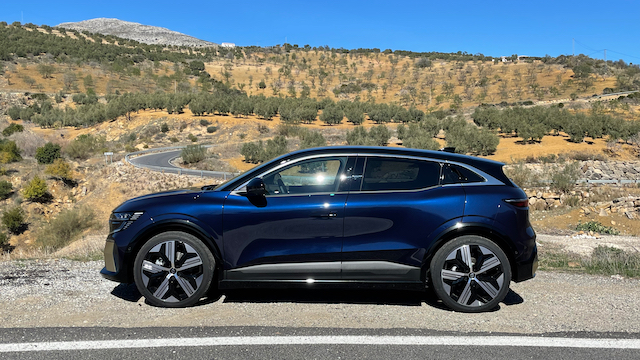
At circa 1.6t the Mégane is a lightweight EV for its size and when you combine its lack of lard with a low drag coefficient and next generation powertrain, the French built EV manages to be remarkably efficient. During testing in ideal weather conditions, we managed power consumption as low as 11kWh and as high as 18kWh per 100km. A class USP that will ensure Mégane receives an enthusiastic welcome will be its ability to charge faster than other EV at standard 22kW public chargers. Most EVs have an onboard 7.5kW (or in some cases an 11kW charger) that allows the car take in AC electricity that it then converts into DC to store in the battery. Most homes cannot charge a car at more than 7.5kW anyway but Renault Ireland says all its Mégane’s will come with an onboard 22kW charger so when you plug in to any of the most common chargers around the country you will be able to draw more electricity when plugged in with your type 2 cable and therefor spend less downtime topping up your battery. For fast and rapid charging, the Mégane Electric has a European standard CCS (AC/DC) combo charge socket and thanks to its new liquid cooled battery it can accept multiple daily fast charges at kW speeds up to double the gross battery capacity – e.g. circa 130kW for the EV60. A 0-100 per cent charge at a 7.4kW home charger will take 9hr11m for the EV60 and 6hr17 for the EV40. At a 22kW public charger the same charge takes 3hr10m and 2hr10m respectfully. At 130kW the EV60 takes 1hr14m. Average combined electricity consumption ranges from 15.5-16.1 kWh/100km WLTP depending on the model.
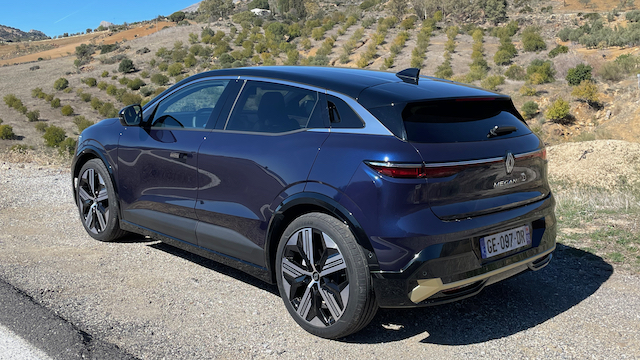
On the road the Mégane is a revelation. The 220hp delivers a GTI-like driving experience with a 0-100km/h time of 7.4 seconds (10.5s 130hp) and its top speed is 160km/h (150km/h 130hp). The car’s low centre of gravity makes it corner with confidence while feeling quite planted on the road. The cabin is a serene environment. Even on the motorway the Mégane is whisper quiet with only tyre noise intruding. Thanks goes to its slippery aerodynamics and heavily insulted battery pack, which incidentally is also a structural part of the car. The suspension is comfortable and firm with a pseudo-McPherson set up at the front and a new multi-link rear axle. On poor surfaces it also impressed us and was never harsh or crashy.
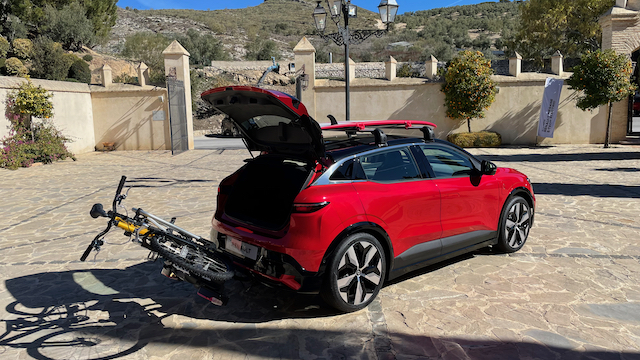
The Mégane has well sorted sporty steering that requires less steering input to turn than its rivals. With a tight 10.4m turning circle and just 2.3 steering wheel turns to go from lock to lock the car feel more responsive and involving to drive. The gear selector is a small stalk on the steering column with simple automatic gearbox lettering. Steering mounted paddle shifters allow a more precise control over the four-stage regenerative braking. Pulling the left paddle delivers incremental increases in braking force, the right paddle less. The Mégane’s front wheel drive set up is less noticeable than in a petrol or diesel car. Only under harsh acceleration will you sense torque steer or momentarily lose traction at the front end when exiting a bend. The ID. 3’s rear wheel drive power delivery a nicer shove in the back sensation. Despite the Mégane’s front wheels having to do two jobs of getting power to the road while also steering the French EV dynamically feels superior to its rivals.
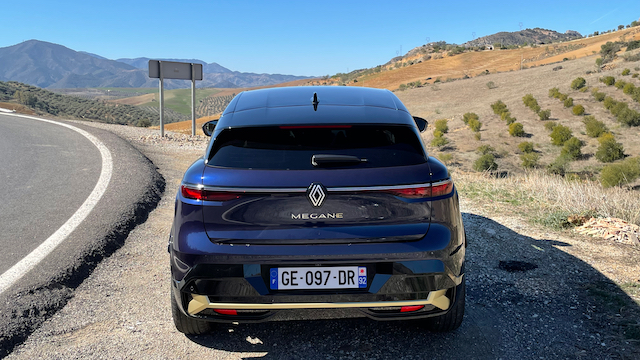
In terms of safety all the latest driving aids and collision avoidance systems (26 ADAS) are available. (ed. Today Renault has announced a five star Euro NCAP crash test result) New Mégane features a QR code on the window that delivers information to emergency services about how to rapidly access/isolate its electrical components and essential features like the location of it fire hose valve (under the rear bench) used to quench a battery fire. The dogs in the street know EV range claims can be literally miles off their official WLTP numbers. Cold winter weather, normal driving styles, motorway use, headwinds, topography can all slash claimed ranges. The new Mégane E-Tech Electric is the first of the brand’s ‘Generation 2’ EVs made in its ‘ElectriCity’ hub in northern France should help renew faith in range claims thanks to its low weight, impressive aero and latest battery and motor technology. Should you need to top up away from home having a 22kW onboard charger as standard is a massive bonus. Renault dealers will get demonstrator stock in early Q3. Renault Ireland is at an early stage in negotiations on unit numbers, pricing etc. but we expect pricing to rival VW ID.3 and SEAT Born pricing. Michael Sheridan


